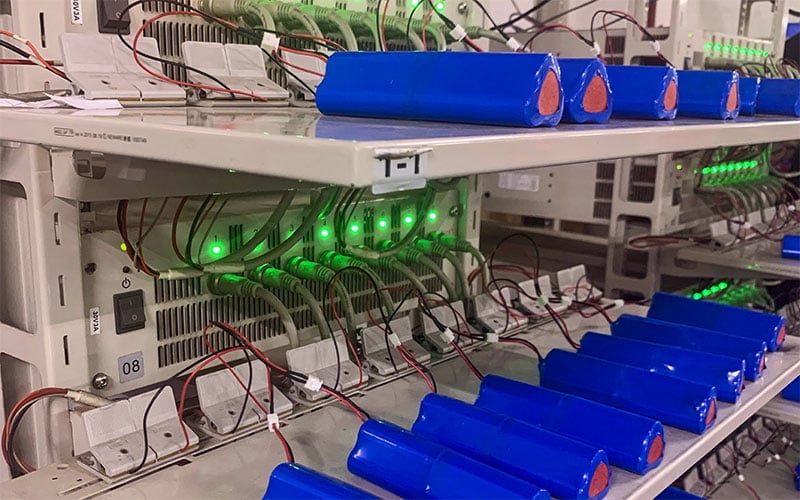Charging batteries, whether they are small batteries in laptops to large ones in electric vehicles, requires the right rate of charge based on the battery chemistry. While technology has provided more ways for people to charge their electronics, especially portable devices, customers are looking at ways to speed up the process so they can use their items faster.
Faster charging options have appeared, yet customers must take care to understand the possible dangers when it comes to charging a battery too fast. In this blog post, we will dive deeper into more about fast charging and safety measures to consider.
What to Understand About Fast Charging
Battery chargers rely on two factors for providing power to batteries: current and voltage. Current entails the amount of electricity flowing through circuits and wires from the charger to the battery. Voltage involves the strength of the electrical current moving into the battery. To get wattage, you multiply the voltage by current as wattage represents the total amount of power.
To perform fast charging, a battery pack manufacturer either changes the voltage rate or the current rate. To change the current, they boost the strength of the current that can pass from the charger and into the battery. To change the voltage, the voltage rate is decreased or lowered based on the battery's current voltage level. It's common for manufacturers to use variable voltages for fast-charging devices versus boosting the current.
Keep in mind that there is always a limit to the charging circuits regarding how much power they can manage. Going over the component's limits may lead to overcharging the battery, battery stresses, extremely high temperatures, and other disadvantages. You will need to ensure the device, charger, and cable can handle fast charging.
When performing fast charging, always charge the battery at moderate or room temperatures. Never perform fast charging in a hot or cold room. Also, ensure that the fast charger has the option to switch over to a regular charge when nearing maximum capacity to limit stresses to the battery.
Which Battery Chemistries Are Capable of Fast Charging?
Not every battery is capable of being charged faster. Understanding the battery chemistry, the operation's power consumption, and the charge rates will allow you to pick the right charging method.

Lithium battery packs charging at charging station.
Lead Acid Battery Charging
Lead acid batteries and certain NiCad batteries are usually slow charged. This factor is due to the battery types undergoing a constant current/constant voltage from the charger. Constant current/constant voltage indicates that the charger has a preset current level and a preset voltage level. The charger moderates the current until reaching the preset voltage level, then reduces the current until the battery reaches full charge.
Technically, a lead acid battery undergoes the constant charge up until reaching a 70% voltage. Then, the charger steps down the current for the remaining 30% voltage, which is called a topping charge. Unlike other batteries that need to be disconnected from the charger once reaching full charge, the lead acid battery can go through a float charge to prevent self-discharge so long as the charger supports that option.
Nickel-Based Battery Charging
Many nickel-based batteries such as NiMH and NiCad can go through different types of fast charging such as rapid, fast, and ultra-fast. When first getting NiCad batteries, they are not primed or fully formatted. So, they must undergo a 16-24 hour charging before being put into use. Both types of nickel-based batteries also go through the constant current/constant voltage methods. Once reaching full charge, the voltage drops to a trickle – called trickle charging – continues as an offset to self-discharge.
Chargers for NiMH batteries apply a step differential method. The batteries go through a fast initial charging to reach the designated threshold and then reduce the charging. At every threshold, the battery and charger go through a cold down period for several minutes before it is resumed.
Lithium-Ion Battery Charging
Unlike other battery chemistries, lithium-ion batteries should never be overcharged. Before the battery reaches maximum capacity, the current needs to be removed. Performing a trickle charge to this battery chemistry may cause plating to the metallic lithium that may cause safety issues. Chargers that have a standby mode can apply a very brief topping to the battery when the battery has a small self-discharge.
Lithium-ion batteries do allow all three types of fast charging methods. All lithium-ion batteries come with a battery management system (BMS) that measures the battery charge, temperature, and other factors. It helps to moderate the temperature of the battery to minimize the risks of thermal runaway, and also helps to avoid undercharging or overcharging lithium-ion batteries.
These controls help to keep the voltage, current, and temperature in control. Yet, keep in mind that any damage to the battery or BMS may still result in damage from overcharging.
Types of Fast Charging
Battery chemistries of NiMH, NiCad, and lithium-ion can go through fast charging. Understanding the battery's C rate helps you to determine how fast of a charge and discharge the battery undergoes. The C rate is the charge/discharge current rate. So, if a battery has a capacity of 10Ah and a current rate of 1C, it means that the battery offers 10 Amps per hour.
Rapid Chargers
Rapid chargers typically charge a battery at a C rate of 0.3 to 0.5. The charger will terminate the current when it senses that temperature, current, or voltage reaches pre-set limits. The chargers also come with a time-out timer. Typical temperatures for these charges are from 50°F to 115°F. When charging at a 0.3C to 0.5C rate, it takes about 3 hours to 5 hours to reach maximum charge.
Fast Chargers
Fast chargers can provide 1C battery current rates; the battery may reach maximum charge within 1 hour or more. Like rapid chargers, the temperatures for charging should remain between 50°F to 115°F. Fast charges also have the same charge termination aspects as rapid chargers. The charger senses the voltage, current, time-out, and temperature of the battery.
Ultra-Fast Chargers
Ultra-fast chargers are limited to specialty batteries allowing for such charge rates. These charge rates range from 1C to 10C. So, the battery may reach a maximum charge within 10 minutes to 30 minutes. Unlike rapid and fast chargers, ultra-fast charges only allow the battery to reach a maximum threshold of 70% state of charge (SoC). Charging temperatures should remain at 50°F to 115°F.
Summary
The one thing to understand about fast charging is if the device goes through excessive charging and discharging cycles, the life cycle of the battery pack may become reduced due to the added stresses. Mainly all batteries perform at their optimal level when they have a moderate charger/discharge rate. If an application requires high current power and faster-charging options, selecting bigger and heavier batteries is ideal. Always speak with a battery manufacturer to determine if fast charging your battery packs is a safe and viable option.
Key Takeaways:
- Fast Charging Relies on Voltage & Current Adjustments:
- Increasing voltage or current can speed up charging, but exceeding limits may cause overheating, overcharging, or reduced battery lifespan.
- Battery Chemistry Determines Fast Charging Capability:
- Lead acid batteries charge slowly, nickel-based batteries allow rapid charging with step differentials, and lithium-ion batteries support all fast-charging methods but require strict monitoring to prevent overcharging.
- Battery Management System (BMS) Ensures Safe Fast Charging:
- The BMS moderates’ voltage, current, and temperature to prevent thermal runaway, overcharging, or undercharging, reducing safety risks.
- Different Fast Charging Methods Exist:
- Rapid chargers take 3-5 hours, fast chargers take about an hour, and ultra-fast chargers charge up to 70% in 10-30 minutes but require specialty batteries.
- Fast Charging Can Reduce Battery Life:
- Excessive charge/discharge cycles create stress on the battery, reducing lifespan; using larger-capacity batteries may help support high-power applications safely.
















